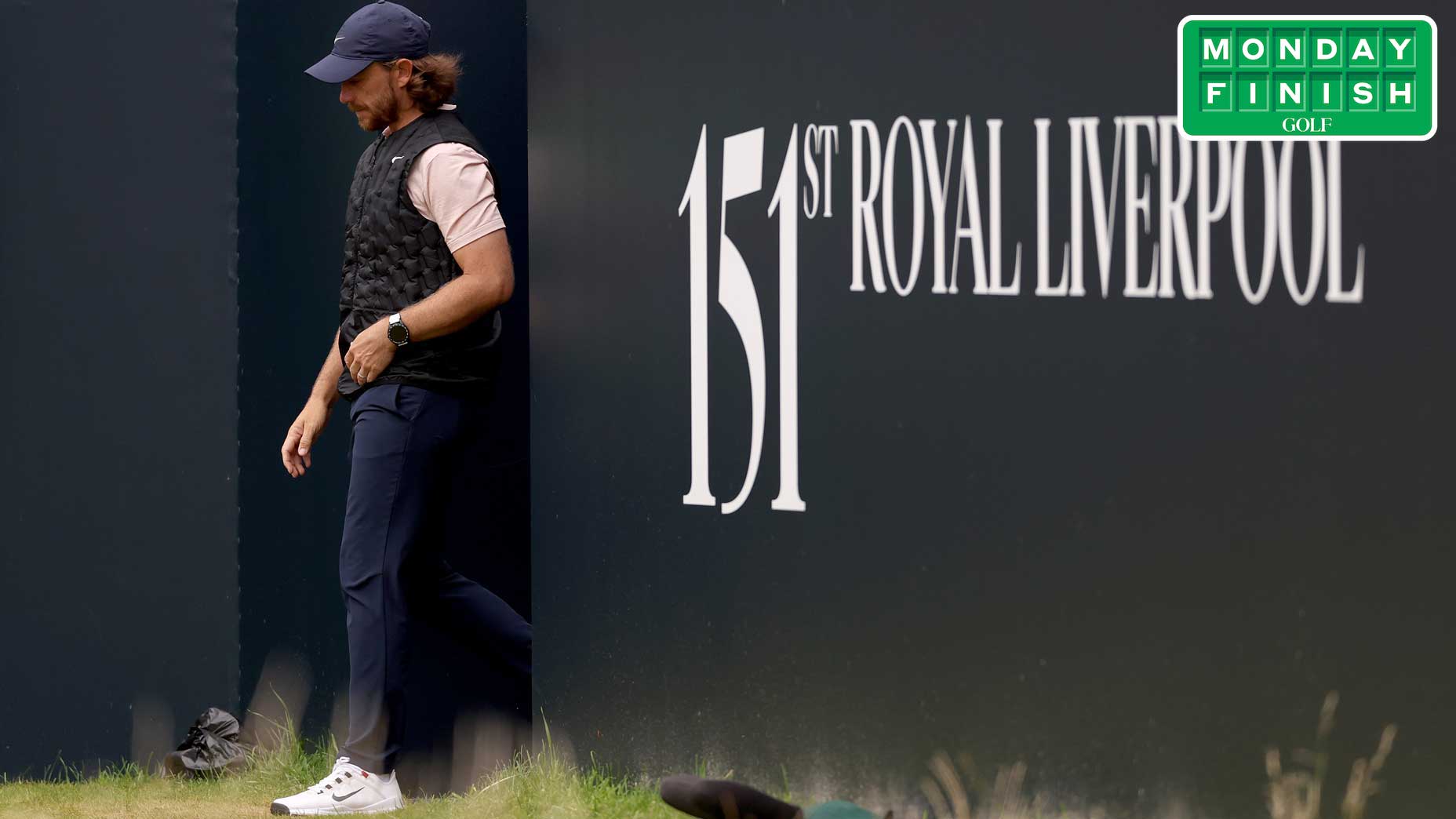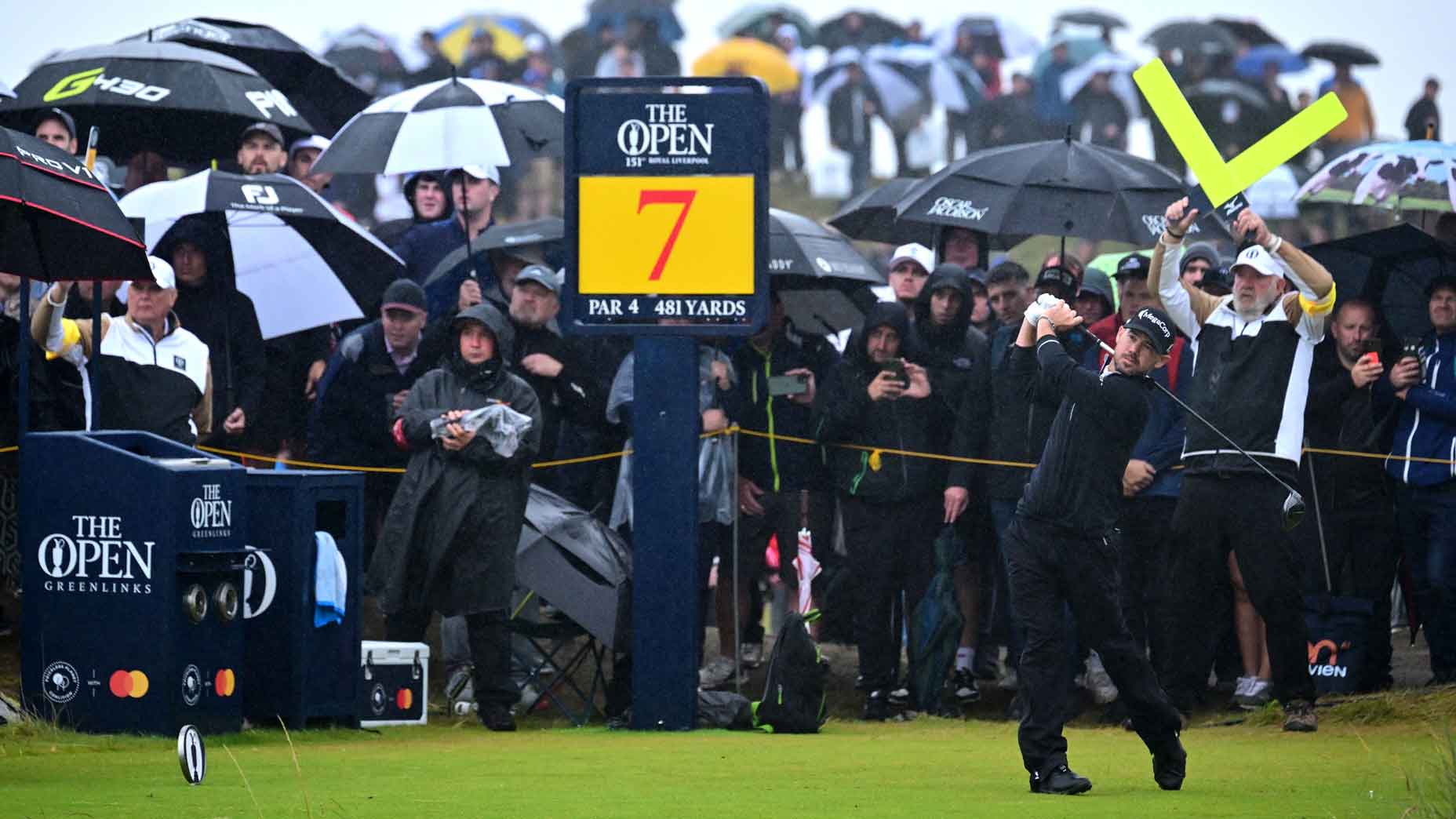For the first time in a long time, your haggis-experienced correspondent is watching the British Open on TV, stateside. Maybe you’re doing the same. Depending on where you are, and when you got to your remote, you woke up to see Willie Z holing out from RSG’s tight fairway turf for an eagle 2 on 12. Or Brooks Koepka hitting driver on the downwind 10th, reachable, nearly, at 420ish. Ish is enough, at this Open or at any Open. You know that whole “trust my number” thing, the mantra of the PGA Tour? It takes the week off. Jordan Spieth, 65. Mmm-mm-m.
It brings to mind his opening 65 at Birkdale, summer of ’17. One morning, at Birkdale, in town, Tommy Fleetwood’s aunt, after church, was breakfasting at the table next to ours. Town and course and beach, all in walking distance. You can’t beat it. At Birkdale. At St. Andrews. At Sandwich.
No event in golf is more aptly named. The clubhouses at Open courses are often cozy and charming, but the courses are vast, wide, windswept — big, open spaces. You can literally get lost on them. One night, playing the Old Course by myself when play was done at Carnoustie, I made a wrong turn and found myself on the New, opened in 1895. The phone deep in my bag rang, and it happened to be a former St. Andrews caddie, Tom Doak. He got me straight. I remember Jay Haas, one year at Muirfield, talking to Curtis Strange about the course right next door. “Did you see this course, this Luffness New? 1894!” They were laughing.
At Royal St. George’s, the Open Championship finds its historyBy: Michael Corcoran
You have courses on top of courses over there, in coastal Scotland, in seaside England. That’s because they’re old, dating back to an era when “ocean view” was not the siren song of every high-end real-estate agent.
But it’s also open in the play-your-way-in sense. Who was expecting Ben Curtis from Ohio to win at St. George’s in 2003? Not Ben Curtis. To say nothing of Jean van de Velde (he won by not) and Paul Laurie (a Scot in Scotland) and Todd Hamilton, flinty American who played the world. If you look at the Thursday tee sheet for the first round, everybody off the first tee, from early morn to late afternoon, it would be almost impossible to be familiar with every golfer in the field. A late-morning threesome: Aaron Rai, Paul Waring, Daniel Craft. I can promise you, without googling a thing, that all three are good at golf, and good enough to dream.
My first British Open was on a color TV (you still distinguished, then) in 1975. The fourth round was on Saturday. The Tom Watson-Jack Newton 18-hole playoff was on Sunday. The thing that stays in my mind, all these years later, was how Watson held his finish and his British racing cap. The first of his five jugs, by a shot. I was smitten. I can’t tell you why.
My first Open in person was in ’85, at Royal St. George’s, caddying for a 22-year pro from New Jersey named Jamie Howell, on his honeymoon, who qualified next door, at Royal Cinque Ports. He’s the longtime golf coach at Eastern Florida State College and a teacher. He’s a lifer, and he and Dawn just celebrated their 36th. As the traditional 50th-anniversary gift is wood, you’re given woolen headcovers for 36.
“Watson caught us on 12,” Jamie reminded me the other day, recalling the Tuesday practice round. “He played four holes with us. I saw him later in the locker room. He says, ‘How was it out there?’ ‘Rough,’ I say. It was blowing. He says, ‘I’ve seen worse, but I don’t know where.’” Tom Watson, 1985. He was god. God was talking to Jamie Howell as an equal, and in a sense they were. They had both played their way into the Open.
Dawn and Jamie and I ate every night at a restaurant in nearby Dover called Dino’s. The place was booked full nightly, but the owner had a table for us every night. Jamie was tipping like an American abroad on his honeymoon, and that surely helped. One night, Brad Faxon walked in, saw the packed house at Dino and said to Jamie, “How’d you get a table?” The things that linger. Jamie played in one other British Open and didn’t make either cut. But he found a life in the game, just like his club-pro father before him.
The stunning Kent coastline 😍 Our setting for The 149th Open #TheOpen pic.twitter.com/4vbapX5kHD
— The Open (@TheOpen) July 15, 2021
The players at Royal St. George’s this week have been talking about the bad bounces the course can give you. And it can. But it can give you a lot of good bounces, too. Jamie will tell you that. Jamie remembers that week just as I do, with incredible fondness. He was starting out, his fresh-out-of-Penn State wife at his side. On it goes. The wind was howling on Friday, in ’85. Jamie played well. He was close.
Princes Golf Club and Royal St. George’s and Royal Cinque Ports are all in a row. They’ve all held Opens. Cinque Ports is spectacular. On the front nine, on the first day of qualifying, Jamie went out in five under. “I remember looking at you on the 10th tee with an expression like, ‘Is this really happening?’” It was. Talk about your peak experiences. He shot 70, low man by two. One of my favorite golf days ever, and I’ve had thousands of them.
When Gene Sarazen won the Open at Princes, in 1932, he had an elderly caddie named Skip Daniels. The Squire gave him his polo coat. Few images in the game have made a deeper impact on me. He wrote about it in “Thirty Years of Championship Golf.” Herb Wind helped with the writing. Fitting surname for a man who loved links golf.
No sentence I know captures the appeal of links golf better than this one, from a short story called Farrell’s Caddie, by John Updike:
“He began to get pars, as the whitecaps flashed on one side of the links and on the other the wine-red electric commuter trains swiftly glided up to Glasgow and back.”
No tournament is better than this one. High noon, come and gone. Rory McIlroy played an approach shot, the wind in his face, the English Channel beyond him. Choke-down mid-iron, sawed-off finish. Your first bit of math is the lie, the second is the wind, the third is you.
Michael Bamberger welcomes your comments at Michael.Bamberger@Golf.com











